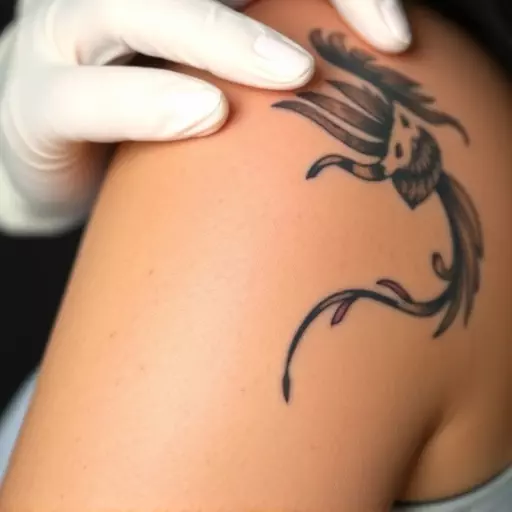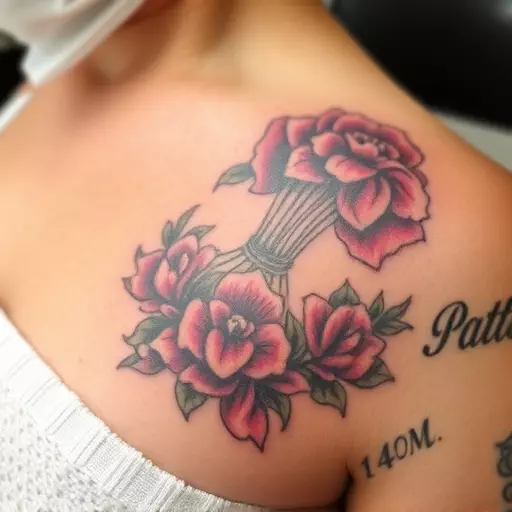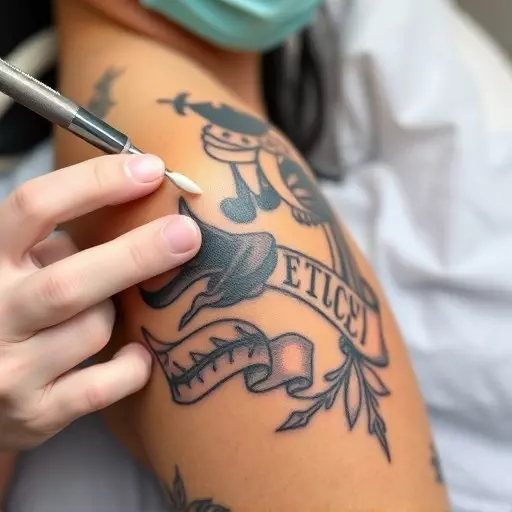In Toledo, tattoo removal offers more than just lasers with popular alternatives like saline tattoo removal and dermabrasion. The former uses a saline solution to break down ink over time, while the latter sands away layers of skin containing ink. These methods cater to specific needs, providing unique benefits for reduced pain, faster recovery, and fading lighter inks. However, they also carry risks like scarring, redness, and prolonged healing. Consulting with a qualified professional is key to selecting the safest, most suitable approach based on tattoo characteristics and desired outcomes. Proper post-care is vital after non-laser removal techniques, including cleaning, avoiding touching scabs, and following provider instructions.
Tattoo removal has evolved beyond laser technology. If you’re considering eliminating an unwanted tattoo in Toledo, explore alternative methods like non-laser tattoo removal practices tailored to your skin type and ink composition. This article delves into various techniques, from the saline tattoo removal technique to dermabrasion, guiding you through pros, cons, safety concerns, and post-removal care for each. Discover the best approach based on factors like tattoo size, color, and your healing preferences.
- Understanding Tattoo Removal: A Brief Overview
- Non-Laser Tattoo Removal Methods in Toledo
- The Saline Tattoo Removal Technique: How It Works
- Dermabrasion for Tattoo Elimination: Pros and Cons
- Safety and Side Effects of Common Tattoo Removal Practices
- Choosing the Right Method: Factors to Consider
- Post-Removal Care: Tips for Optimal Healing
Understanding Tattoo Removal: A Brief Overview

Tattoo removal is a process that has evolved significantly over the years, offering individuals more options than ever to get rid of unwanted ink. While laser tattoo removal remains one of the most popular and effective methods, there are alternative techniques available for those who prefer non-laser approaches or have specific considerations. In Toledo and beyond, these alternatives are gaining traction due to their unique benefits and targeted results.
One such method is saline tattoo removal, a procedure that involves injecting a saline solution into the tattooed skin. This solution helps to break down the pigment over time, allowing the body to naturally absorb and eliminate it. Dermabrasion is another non-laser technique where a rotating brush is used to sand down the surface of the skin, gradually removing layers of ink until the tattoo fades away. These methods provide viable alternatives for individuals who may have concerns about laser exposure or desire a more subtle approach to tattoo removal.
Non-Laser Tattoo Removal Methods in Toledo

In Toledo, those looking to remove their tattoos beyond laser treatments have several non-laser tattoo removal methods available. One such alternative is the saline tattoo removal technique, which involves injecting a salt solution into the tattooed area to break down the pigment over time. This method is often less painful and has shorter recovery periods compared to laser removal.
Another popular non-laser approach is dermabrasion, where a specialized device gently sands away the surface layers of skin containing the tattoo ink. Dermabrasion can be effective for smaller or lighter tattoos, but it may not be suitable for all skin types or colors. It’s crucial to consult with a qualified professional who can guide on the most appropriate non-laser tattoo removal methods based on individual needs and circumstances.
The Saline Tattoo Removal Technique: How It Works

The Saline Tattoo Removal Technique is a non-laser approach that has gained popularity as an effective method in Toledo, offering an alternative to traditional laser removal. This process involves the use of a saline solution and specialized equipment to carefully break down and remove tattoo ink particles from the skin. During the procedure, a small needle is used to inject the saline solution into the tattooed area, which creates micro-lesions in the skin. Over time, these micro-lesions facilitate the body’s natural process of healing and elimination of foreign substances, effectively fading the tattoo.
Dermabrasion, another non-laser technique, serves as a complement to this method. It involves gently sanding down the surface layers of the skin to remove the topmost portion containing the tattoo ink. While dermabrasion may not be suitable for all types or colors of tattoos, it is particularly effective for lighter or newer tattoos. Combining these non-laser methods can provide promising results for those seeking tattoo removal without the use of lasers, catering to individuals who prefer alternative solutions in the Toledo area.
Dermabrasion for Tattoo Elimination: Pros and Cons

Dermabrasion is a non-laser tattoo removal method that involves gently sanding down the skin’s surface to eliminate the visible pigment. This technique, while effective, offers both advantages and drawbacks. One of its key benefits is that it’s suitable for various skin types and colors, making it a versatile option in Toledo for those seeking non-laser tattoo removal methods. It’s particularly effective for lighter ink colors, including saline tattoo removal, where the salt solution helps to dissolve the pigment during the process.
However, dermabrasion can be more invasive than some other procedures, leading to potential side effects such as scarring, temporary discoloration, and increased sensitivity in the treated area. The recovery period may also be longer compared to laser treatments, requiring patients to take time off work or other activities to allow their skin to heal properly.
Safety and Side Effects of Common Tattoo Removal Practices

When considering tattoo removal, it’s crucial to understand the safety and potential side effects associated with different methods. Common non-laser tattoo removal practices include saline tattoo removal and dermabrasion, each with its own set of considerations. The saline tattoo removal technique involves injecting saline solution beneath the tattoo to break up pigment particles over time, but can cause temporary redness, swelling, and pain at the treatment site. Dermabrasion, a process where a machine gently sands down the surface layers of skin containing the tattoo, may result in scarring, infection, and prolonged healing periods.
While these non-laser methods offer alternatives to traditional laser removal, they are not without risks. It’s important for individuals exploring tattoo removal options in Toledo to understand these potential side effects and consult with a qualified professional who can guide them through the best approach based on their specific tattoo size, color, and location.
Choosing the Right Method: Factors to Consider

When considering tattoo removal, it’s crucial to understand that not all methods are created equal. Beyond laser treatments—a common but not universally effective option—there are several non-laser tattoo removal methods available in Toledo. One promising technique gaining traction is saline tattoo removal, which involves carefully injecting a patient’s body with saline solution to break up the pigment over time. This method is particularly appealing for those looking for a more natural approach and can be an excellent alternative for people with certain skin types or concerns about laser sensitivity.
Another physical exfoliation method is dermabrasion, where a specialized device is used to sand down the surface of the skin, removing layers that contain tattoo ink. While this process may leave temporary scarring and requires skill to avoid, it offers a permanent solution for some types of tattoos. Choosing the right method depends on factors like tattoo size, color, age, skin type, and individual healing capabilities. Consulting with a specialized professional is key to determining which technique aligns best with your specific needs and desired outcomes.
Post-Removal Care: Tips for Optimal Healing

After tattoo removal, proper post-care is essential for optimal healing. Regardless of the method used—including non-laser tattoo removal methods in Toledo like saline tattoo removal or dermabrasion—the initial steps are crucial. Keep the treated area clean and dry to prevent infection; use gentle, fragrance-free soap and warm water to cleanse the skin gently but thoroughly. Avoid touching or picking at the scab that forms, as this can lead to scarring.
Apply a thin layer of moisturizer to keep the skin hydrated, but be careful not to use products containing oils or fragrances. Over-the-counter pain relievers can help manage any discomfort during the healing process. It’s important to follow your healthcare provider’s specific instructions for post-removal care, as factors like sun exposure and certain activities may need to be limited to ensure the best possible outcome.


